This site contains affiliate links. As an Amazon Associate, I earn a commission from qualifying purchases at no extra cost to you. Full Disclosure Here.
In this article, we discuss the top 15 long-range rifles for 2024, covering different styles such as target shooting, hunting, and tactical precision. Key factors like precision, accuracy, caliber selection, and barrel harmonics are considered. The rifles are evaluated based on their performance, cost, and aftermarket parts availability, providing insights for both beginners and experienced shooters.
Interested in getting into long range precision shooting? As a former USMC Scout Sniper and a current US Army contractor, I have qualified and tested many “sniper rifles”.
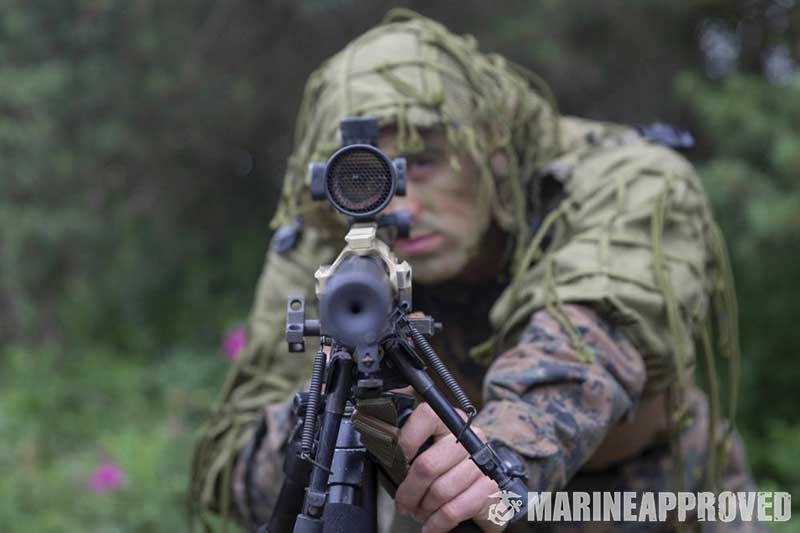
Some of these rifles were fielded to Scout Snipers and Army Snipers, while others didn’t quite make the cut. In this article I’ll be sharing some of my knowledge with you and hopefully help you choose a new rifle to get you into the sport.
At A Glance: Our Top 5 Picks For Long Range Rifles in 2024
- Best Value: Ruger Precision Rifle
- Lightweight & Rigid: Bergara B14 HMR
- Alternative #1: Tikka T3x TACT A1 Rifle
- Alternative #2: Bergara Premier Ridgeback
- Used by Police & Military: Remington 700 ADL
First off, understanding the importance of precision shooting is, in my opinion, the most interesting thing in this sport to begin with. Precision weapons have been used to assassinate political figures, high ranking military leaders, and have started and ended many major wars and battles.
One single shot can mean the difference between feeding your family or going hungry. One single shot can turn the tide of a battle and consequently, write history. Let’s look at an example.
May, 1864. Spotsylvania Court house. Union Major-General John Sedwick was watching his troops emplace cannons for an upcoming battle. The cracking of hexagon shaped bullets fired from confederate snipers had Union troops lying down for cover. “I am ashamed of you, they couldn’t hit an elephant at this distance” he said, which would become his last words.
A moment later, a bullet penetrated his skull just under his left eye, dropping him immediately. He was the highest ranking Union officer to be killed in action during the war. One shot.

As time went by, improvements in precision weaponry were made and maximum effective ranges began to increase. It is said that in Vietnam, the average number of rounds expended per kill with the M16 was 50,000. Snipers averaged 3 rounds per kill. That’s a cost difference of $2300 vs. 27 cents. The combat effectiveness of a precision rifle plays psychological terror on an enemy, and the equipment can essentially pay itself off.
Today, precision rifles have come a long way. Specially trained snipers, equipped with the right weapon, have recorded kill shots at incredible distances, with the record being currently held by a Canadian sniper out to 3540m!
Enough with the sniping. Let’s start narrowing down how to find the right rifle for you. The first thing you should consider is how you’re going to be using this rifle. Steel plate shooting? Hunting? Defending your neighbor’s house that’s in another zip code?
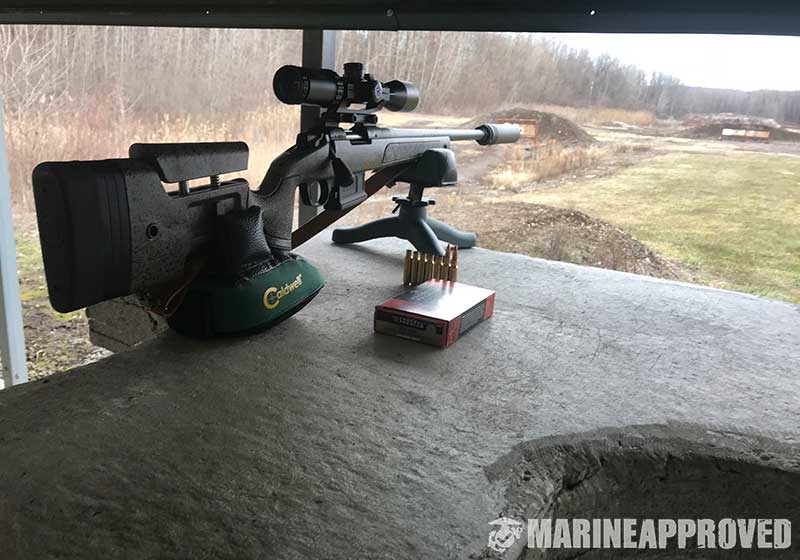
Regardless of your intended use case, this guide and list of rifles should definitely help select your next rifle.
For those of you who want to learn more about long range rifles, triggers, stocks, muzzle brakes, suppressors, long range caliber options, scope pairing, types of barrels, barrel harmonics, and more, I recommend reading the guide portion of this article. For those of you who want to skip straight to the rifle reviews, I’ve placed a quick navigation menu below.
| IMAGE | PRODUCT | |
|---|---|---|
Best Value 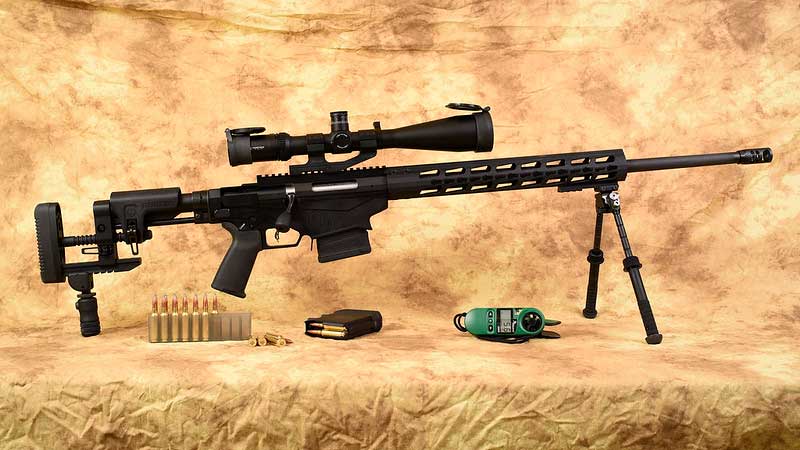 | Ruger Precision Rifle
| VIEW ON SPORTMANS → |
Lightweight & Rigid  | Bergara B14 HMR
| VIEW ON SPORTMANS → |
Alternative #1 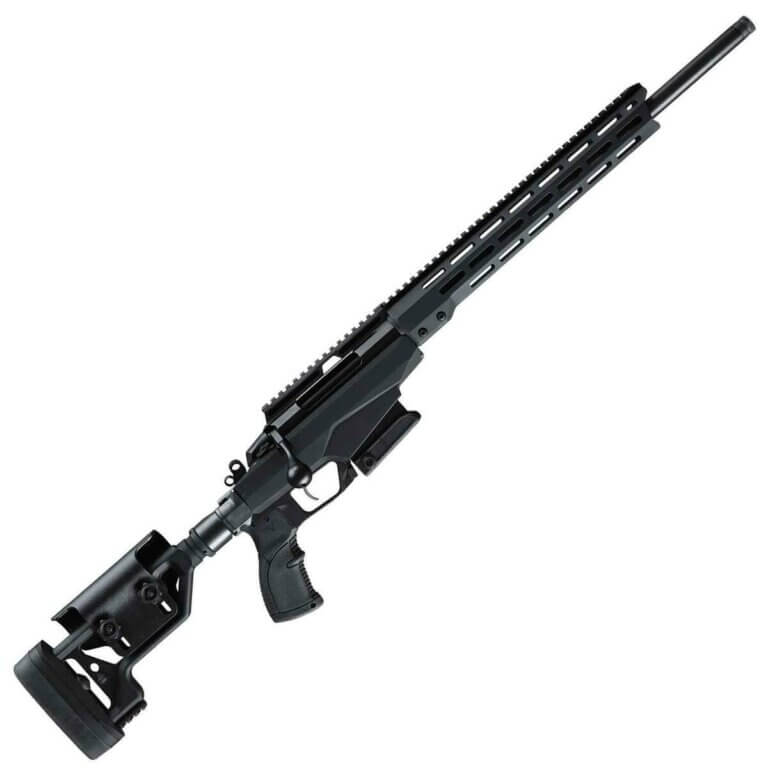 | Tikka T3x TACT A1 Rifle
| VIEW ON SPORTMANS → |
Alternative #2 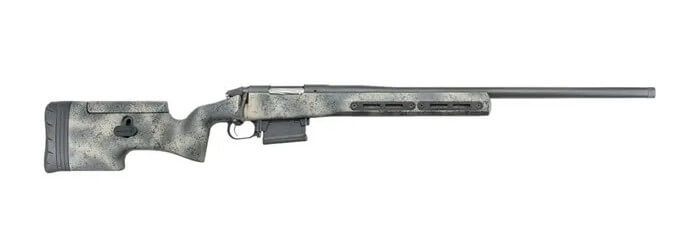 | Bergara Premier Ridgeback
| VIEW ON SPORTMANS → |
Used by Police & Military 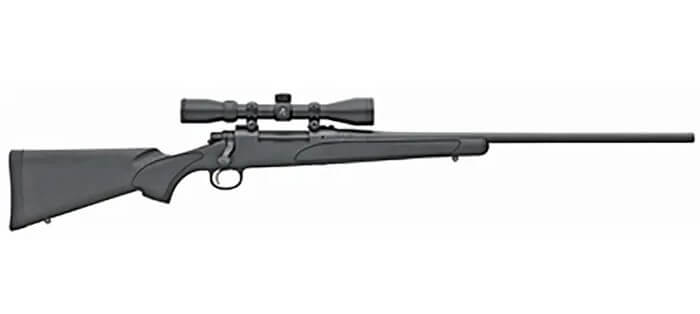 | Remington 700 ADL
| VIEW ON SPORTMANS → |
Factors to Consider When Choosing a Long Range Rifle
Here we addresses key aspects such as precision, cost, aftermarket parts availability, style of the rifle (target, hunting, tactical), and the rifle’s performance characteristics like barrel harmonics and caliber selection. These criteria help in selecting a suitable rifle for specific needs, balancing factors like accuracy, durability, and budget.
Long Range Rifle Styles
Target Shooting Rifles

Keep in mind that a good target shooting rifle will generally be much heavier than any other. The increased weight in the barrel and stock adds rigidity to the rifle, which makes it much more precise. These will typically not be practical for your typical elk hunt in which you have to walk 12 miles through the mountains to your hunting spot.
Hunting Rifles
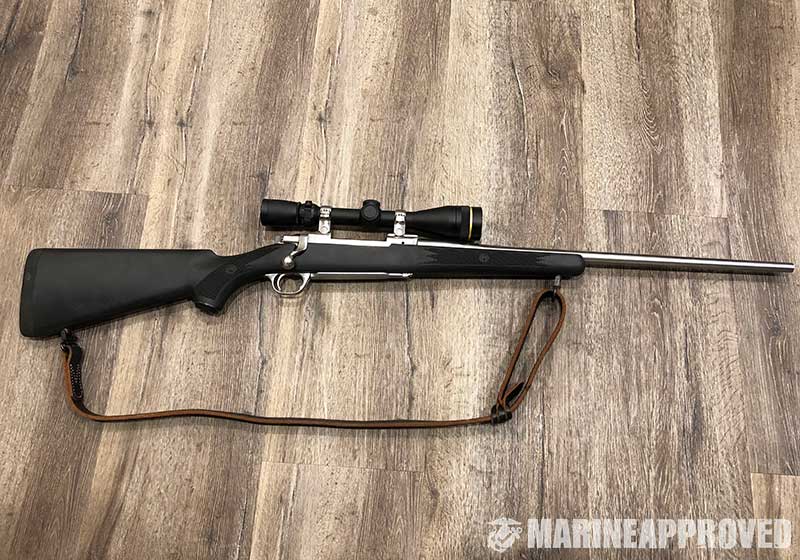
Hunting? You’ll want something lightweight because you’ll likely be going on long hikes around natural obstacles and potentially difficult terrain. Hunting rifles typically are not shot nearly as much as target shooting rifles, therefore a lightweight stock and shaving weight by fluting the barrel might be a good option. Reducing weight may reduce the rigidity and precision of the rifle, but not by much
While looking for a hunting rifle you should be prioritizing getting to your treestand with enough energy to continue the hunt, over a couple of extra pounds for a slight increase in precision. Remember, ounces equal pounds, and pounds equal pain.
Tactical Precision Rifles

Got more of a tactical idea for a precision rifle? Maybe for PRS shooting competitions, or just knowing that you could hit a human sized target at 1,000 yards in a zombie apocalypse? These rifles fall in between a heavy target rifle and a lightweight hunting rifle.
A heavy, bull barrel paired with a lightweight Chassis system typically gives a great precision rifle that the shooter can run with from obstacle to obstacle, taking precision shots at multiple targets in a short time. These are generally the happy medium, which can be carried on a hunting trip and still ping steel at 1,000 yards.
Rating Criteria to Make This List
Here are some criteria rifles had to meet to make this list.
Precision: 1 MOA or better. Face it, if the rifle isn’t holding a 1” group or less at 100 yards, you’re never going to hit human sized targets at 1,000. Toss the rifle and grab a machine gun.
Cost: Less than $2000. Nobody wants to go to the range to do some explosive therapy to come home to an angry wife yelling about how you spent all the savings on ANOTHER gun. We’ve all been there before, right?
Aftermarket parts availability: There’s nothing more convenient than being able to go to your local sporting store and pick up parts that work with your rifle. Or even shopping online for hundreds of aftermarket accessories you can use to tailor your rifle just to you, like a finely fitted suit.
Understanding Precision vs Accuracy
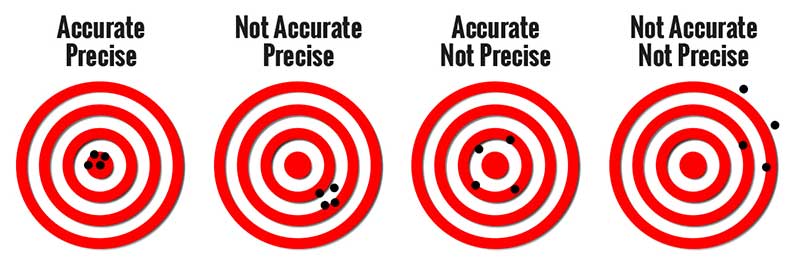
What exactly is precision? Is it the same as accuracy? No, it’s not. Precision is the measured reproducibility or repeatability of a system under unchanged conditions. Accuracy, on the other hand, is a measurement or the degree of closeness to a measurement to a specific target value.
Basically, your rifle either shoots very precisely, or it doesn’t. How accurate you are with that rifle is all on your fundamentals of marksmanship.
Let’s talk about how precision ratings play a role in choosing your first long distance rifle. Many of these precision rifles come with a precision guarantee, usually “1 MOA or less.”
For those of you who do not know, 1 Minute of Angle (MOA) is basically equal to 1 inch at 100 yards. A “three minute gun” would be one that holds a 3 inch group at 100 yards.
For precision and long distance shooting, you want the gun to be as precise as possible. Therefore, strive for the tightest precision rating, such as .5 MOA. If the rifle isn’t shooting 1″ groups or less at 100, it’s not what you want for long distance shooting.
Think about it, 1 MOA means 1″ at 100 yards. That same angle would get you 10″ at 1000. And that three minute gun that’s been tossed around the back of the truck for generations is holding 3″ at 100, which would get you to 9″ at 300.
The best way to find out how precise the rifle is REALLY shooting, is to just ask around the firearms community. Ask people how tight their groups are with a specific rifle, and then ask what type of load they are shooting.
Most precision shooters do their own load development and create their own “recipes” that their rifle shoots most precisely with. Or, ask them which factory off-the-shelf ammo seems to provide the most precise groups.
Long Range Caliber Selection
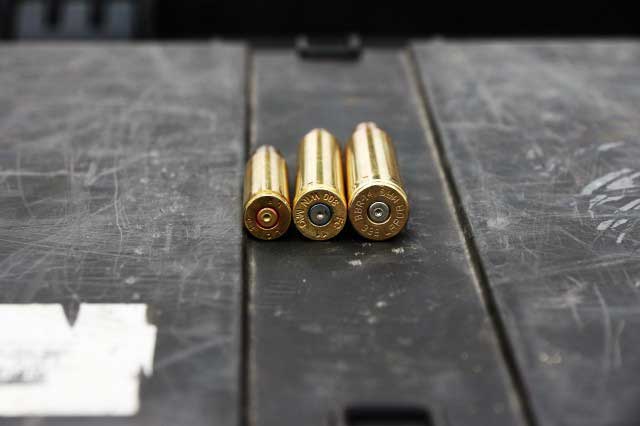
After you’ve narrowed down the scope of your mission and what you really want out of our precision rifle, let’s make probably the most difficult decision in the selection process. What your rifle is going to be chambered in.
There are so many choices out there. There’s the proven .308 Winchester, the most popular short-action hunting cartridge in the world. The 6.5 Creedmoor, a more recent cartridge designed specifically for long range target shooting, also having success as a good hunting round.
You can go out to extremely long ranges with the .50BMG. And I won’t fail to mention other contenders such as the 408 Chey-Tac, .338 Lapua, 300 Win Mag, etc.
There are so many factors and so much that goes into this decision that wrote a full article long range calibers here.
Popular Article: 21 Best Red Dot Sights (Ranked by a Marine)
If you’re a beginner looking to get your first precision rifle, I’d recommend a .308 or 6.5 Creedmoor, simply based on the availability. It seems like almost every rifle right now is offered in one of these cartridges and almost every sporting store is basically guaranteed to carry one of these two rounds.
Once you know what style of precision rifle you’re looking for and you’ve decided which cartridge to go with, there are a few other characteristics for you to keep in mind.
Barrels and Barrel Harmonics
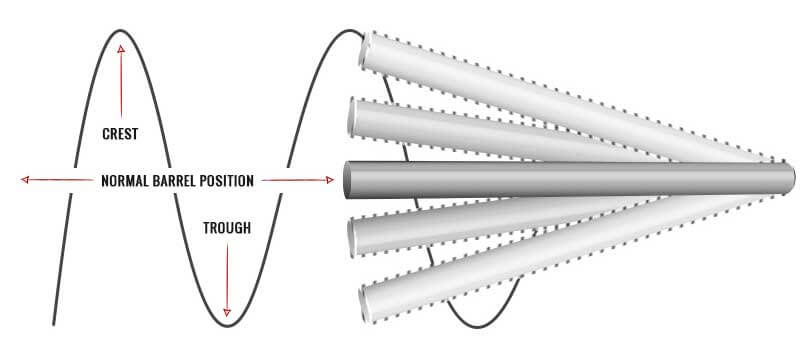
Let’s go over barrel harmonics real quick. Every time a round is fired the barrel “whips”. These are microscopic vibrations in the barrel that should be understood. See the picture above for a representation.
The vibrations need to be tamed in order to increase precision. How can that be done? By increasing rigidity. A short, fat barrel, is much harder to whip than a long skinny one. Imagine a short, thick pipe and a long skinny pipe. The long skinny pipe will be much easier to “whip”. This is the idea behind heavy barrels, also known as bull barrels. Another benefit of having a heavy barrel is that there is more metal to conduct heat away from the bore, providing a longer barrel life.
Now let’s get into fluted barrels. Is fluting a barrel bad for accuracy? Not necessarily. The more material that is there, the more rigid the barrel will be.
Imagine taking that short thick pipe we were just talking about, and carving flutes into it. Is it less rigid than it just was? Unfortunately, yes. Is it still more rigid than the long skinny pipe? It depends on the exact dimensions, but most likely yes. The main benefit of fluting a barrel is weight reduction.
As mentioned earlier, ounces equal pounds, and pounds equal pain. Very rough estimate here, but fluting a barrel could get you about a 35% weight reduction, 45% loss of rigidity, and a surface area increase of about 65%.
Increasing the surface area assists in the heats convection process, meaning the heat has much more cooling surface to dissipate from the barrel into the surrounding environment.
Free Floating Barrels
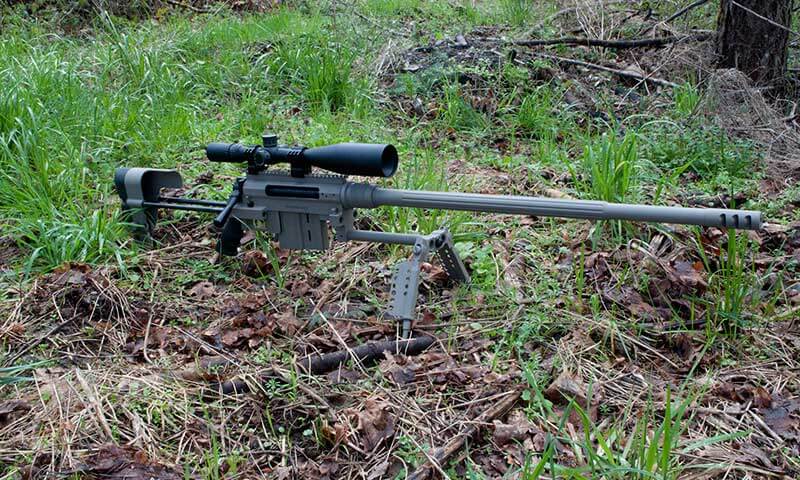
Barrels are considered to be free floating when there is no contact between the barrel and stock.
The barrel is attached to the receiver, which is attached to the stock, but the barrel floats freely without any further contact. This is good, as there is nothing to affect the barrel harmonics or the barrel’s microscopic vibrations. Precision rifles will almost always be free floating.
The golden rule with precision shooting is that consistency is accuracy. If you shoot with a suppressor, always shoot with the suppressor to get the same results. If you shoot one type of ammo, don’t load another type and expect to get the same result.
Say you do not have a free floating barrel, meaning the stock is touching the barrel. And your sling Is attached to the forend of the stock. The tightness of your sling could lead to inconsistent pressures being applied to the barrel, shifting your point of impact around slightly. These slight inconsistencies may seem unimportant and might only cause shifts of about 1/8″ at 100 yards. But, when you get out to 1000 yards, that 1/8″ will open up to 2.5″.Combine a couple of errors and you’ll be seeing a point of impact shift of several inches at longer ranges.
Another thing to keep in mind here is barrel length and rate of twist. You just want the barrel to be long enough to burn off all the powder, and that’s it. Any shorter or longer, and you’ll slow the bullet down. The rate of twist needs to be correct so that it can properly stabilize the projectile in flight. Too fast of a twist, and you’ll over stabilize the bullet. Too slow, and the bullet won’t be properly stabilized. You usually won’t have to worry about this, though, as reputable rifle companies won’t sell a rifle with an improper length or twist ratio.
Types of Barrel Rifling
Here is a good video that explains the differences between the two types of rifling we will be discussing here, conventional and 5R.
A rifled barrel consists of a series of lands and grooves inside the bore. These lands and grooves cause the bullet to spin. The speed of this spin is known as the Rate of Twist (ROT). It is presented in a ratio, inches per turn. So a 1:10 rate of twist means that the bullet will turn one time, every 10 inches. Having a rate of twist too tight, and you can blow out the lands in your barrel and cause serious damage. A twist rate that is too tight can also over-stabilize the bullet, as a rate of twist that is not tight enough will fail to adequately stabilize the bullet in flight.
There are two major types of rifling that I will cover. Conventional rifling, and 5R rifling. Conventional rifling, as pictured above, has 6 lands and groves. They have sharp 90-degree corners from the top of the land to the bottom of the groove. Notice that the lands are perfectly opposite of each other. The bullet will essentially be “pinched” between the lands, leading to the deformation of the bullet under extreme pressure. The 90-degree lands cut the jacket, creating more copper fouling. It is also harder to clean, as the debris is compacted in the corners against the 90-degree lands, which is hard to reach.
The other type of rifling is known as 5R rifling. It was made popular by the US Army’s M24, which was a Remington 700 action fitted with a unique barrel featuring the 5R rifling. The 5R rifling uses 5 lands and grooves, instead of the conventional 6. This places the lands opposite the groves, which reduces the projectile deformation by keeping the round from being “pinched” by lands on opposite sides. This in turn increases projectile uniformity and consistency. The 5R rifling also provides a better gas seal. The lands are beveled out to 110-degrees, instead of 90-degrees. This reduces the amount of copper fouling caused by the lands cutting into the jacket. The 110-degree lands are also easier to clean, as it is easier to reach the debris when it is not packed tightly into a sharp corner.
My intentions are not to steer you away from conventional rifling. If a rifle has conventional rifling, it still will likely shoot just fine. Barrels have been rifled with conventional rifling for a long time without issue and are still being manufactured with conventional rifling. Just understand that 5R rifling is a slightly different, updated method of rifling barrels. There are a few different land profiles to choose from on the market, but these seem to be two of the most popular today.
Scope Pairing
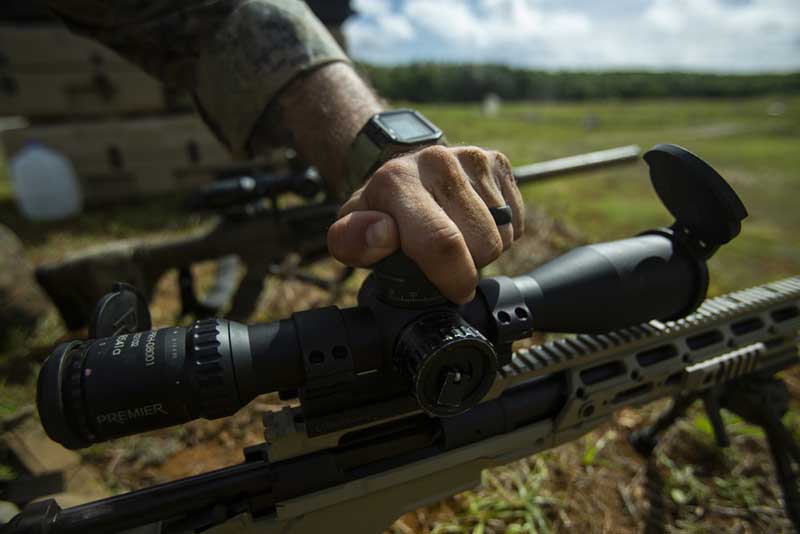
Now another big one, rifle scopes. This topic is so diverse and so dependent on your shooting goals that it can’t all be covered here. We actually have an entire guide on dedicated to long range scopes that you can check it if you want an in-depth guide.
Related Article: 17 Best Long Range Scopes (Ranked by a Marine)
What I will touch on is, expect to spend some money. A big mistake a lot of shooters make is not buying a scope that matches the quality of their rifle. What’s the point of having an incredibly precise rifle if you put a beer bottle on top of it as a sight? When it comes to scopes, you generally get what you pay for.
Trigger Considerations
Once the trigger drops the firing pin, the trigger has no affect on precision at all. However, that doesn’t mean go cheap on a trigger. A good trigger will hide a tremendous amount of bad trigger control.
A good shooter can overcome a bad trigger, but I always recommend purchasing a quality trigger, regardless of experience. If you’re flinching, bucking, or jerking the trigger, you’ll notice a decrease in accuracy. Upgrading your trigger can show an increase in accuracy. There are two types of triggers to keep in mind. Single stage and two stage triggers.
Single stage triggers are very basic and simple triggers. In simplified terms, AS the trigger is pulled, the hammer is released.
Two stage triggers are more common in precision rifles. As the name suggests, there are two stages of trigger pull. In the first stage, the trigger is pulled back lightly until a “trigger wall” is felt, at which point it will be slightly harder to pull back, but once the trigger wall is broken, the hammer will be released.
Next, let’s talk about adjusting your trigger. Most triggers either have an adjustable pull weight or are sold in different pull weights. A lighter trigger pull, around 2 pounds, provides that feeling of basically “breathing” on the trigger to fire the weapon. While a heavier pull can be around 9 pounds. The NYC police department outfitted its officers Glocks with a 9 pound trigger pull. This is due to the fact that in high stress situations, such as combat scenarios or even a case of “buck fever” in the tree stand, it is common to lose fine motor skills. This can lead to negligent discharges from people not realizing how much pressure they’re putting on the trigger. A Mil-Spec AR trigger is generally around 4-5 pounds, while precision rifle triggers are commonly found to be around 1.5-2.5 pounds.
Stocks

In my opinion, this is the fun part. Selecting your stock. You could equip your rifle with a beautiful high gloss American walnut stock or go with a more tactical feel on a McMillian A5.
For precision rifles, stocks are generally made out of fiberglass or carbon fiber. Wooden stocks are more popular in hunting rifles. Keep in mind, however, that wood can warp, swell, or crack over time.
If the barreled action isn’t properly mounted in the stock, the rifle will not shoot to its full potential. A technique known as bedding, can be done to stocks to increase accuracy. Glass bedding involves molding an epoxy based product into the stock to fill in gaps and create a precisely fitted contact surface between the stock and action.
Bedding the action essentially creates a perfect fit for the action to fit inside the stock, eliminating the risk of having the action moving around in the stock. Bedding also increases rigidity and durability, which will provide an increase in precision.
Instead of a stock, there’s the option of a chassis system. Chassis are typically constructed of aluminum. A chassis system is much simpler to install correctly.
Chassis systems have a V block to hold the receiver, with two solid points of contact to keep it in place. This mechanical form of bedding significantly improves accuracy and negates the mess of dealing with liquid bedding compounds. Chassis systems usually offer much more versatility than a standard fiberglass stock.
Many accept AR15 parts and accessories, such a pistol grips, adjustable folding stocks, and rails. They are also often outfitted with detachable magazines. The versatility and customization of a chassis system can really allow the shooter to tailor the rifle to fit their body and style. While a chassis system is often slightly lighter than a stock, a properly bedded stock is normally a little bit more precise.
One other form of bedding is known as pillar bedding. Pillar bedding is a relatively simple gunsmithing technique of using “pillars” to support the rifles action, stopping unwanted movement of the action inside the stock. Bedding pillars are a big help in wood stocks, but are still beneficial in fiberglass/composite stocks as well. If the material the stock is made of can compress, it would benefit from pillars. Therefore, pillars are not needed in a metal bedding block.
As wooden rifles are exposed to temperature and humidity changes, the wood can consequently swell or warp. As the wood expands and contracts due to these changes, accuracy is affected. Shooters would use torque wrenches to tighten action screws, pressing the action tightly against the stock, to eliminate action movement within the stock. This helps maintain accuracy and maintain its point of impact over time. Eventually, shooters found that placing metal sleeves, or pillars, in the action screw holes would ensure the correct and consistent screw torque.
Muzzle Devices
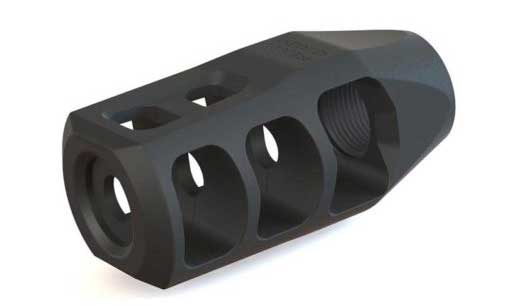
Nine times out of ten, precision rifles on the market today will come with a threaded barrel and thread protector included. What does that mean for you as a consumer?
More research will need to be done on your end to choose a muzzle device that fits your mission and budget. Thinking about skimping on the 100 bucks and running your rifle without one? A muzzle brake or suppressor can drastically reduce felt recoil, leading to much stronger fundamentals like trigger control and follow-through that new and experienced shooters must learn and master. Reduced recoil also allows the shooter to stay on target for a follow up shot if necessary.
Now let’s first break down what a muzzle device is and what it can do to improve your rifle system. They can be divided into four categories: Muzzle Brake, Flash Hider, Compensator, and Suppressor. Since only brakes and suppressors are normally found on precision guns, I’ll focus on those two.
Muzzle Brakes
A muzzle brake is a female threaded device that takes the rapidly expanding gas coming out of the barrel and redirects it to the side or at an angle opposite of the bullet direction. By redirecting the gas, the brake acts similar to a reverse thrust system on a jet engine aircraft. This counter acting force does not eliminate recoil, but can reduce it up to 60%. Utilizing a muzzle brake on your precision rifle is recommended for shooting calibers 300 Win Mag and above. Some people would even say all precision rifles, except very heavy light recoiling rifles.
One downside to running a muzzle brake on your system is that it creates added concussive force experienced by the shooter and will negatively affect anything near the muzzle. If you have ever been in a shoot house conducting CQB drills or in direct action urban combat overseas, you definitely know the feeling of your buddy shooting his/her rifle in close proximity to your face. That OOMPHH you feel is what I mean by added concussive force. One anecdote I will share is a buddy of mine was shooting my bolt gun off his tailgate, as most of us do. We were shooting steel across a pond in a sand and gravel pit. I was sitting in my chair in the bed of his truck, spotting for him, trying to find what he was targeting. I looked down one last time to check his barrel location to find his target and the words didn’t come out fast enough….BANG. I forgot to warn him to keep the muzzle away from the taillights. Sure enough… broken taillight. He traversed a bit too far left. If a muzzle brake is a part of your current or future build, be mindful of the direction that your brake is configured when firing close to other objects or people.
That being said, as a precision shooter myself, I prefer to have muzzle brakes on every gun I build. Having that extra edge on recoil management is well worth the added money and slight discomfort.
Suppressors
If you’re new to precision rifles or tactical firearms in general, you’ll be interested to find out that suppressors and muzzle brakes are often designed hand-in-hand to create a modular, user-friendly, gas management system.
Purchasing a suppressor today will require you to file a separate application for a tax-stamp to the ATF, along with with fingerprint cards and $200…the original application fee from 1934. God-Willing, you will receive your approved tax-stamp in approximately 4-8 months, depending on current wait times.
Suppressors Today
As the market becomes further bombarded by these devices due to a massive increase in popularity, you as a consumer must do your homework.
Suppressors can be broken down into two main categories: direct thread and QD or quick detach. I will briefly cover direct thread suppressors because they just simply aren’t as practical. That being said, direct thread does have its advantages. For one, some say that direct thread cans seal better, therefore less loss of gas coming out of the crown of the barrel. Also, direct thread options overall, are cheaper. You don’t need to buy a certain muzzle device to accept the suppressor like you do with the QD options. However, as an experienced long gun shooter with suppressors, I tend to still lean towards the QD option.
Quick Detach suppressors come in all different sizes and variations. All in all, there are at least six reputable manufacturers who make QD options for your setup. The most common suppressor in this category would be the “30 Cal” can. 30 Cal meaning a suppressor to accommodate the 7.62 class projectile. One major plus to purchasing a “30 Cal” can is that you can mount the same device on your precision bolt gun, as you would on your standard go-to AR-15. Many companies now are building smaller and smaller cans that work just as well and are aesthetically appeasing on smaller guns. Some things to keep in mind while looking for a suppressor to fit your needs…overall weight, length, and diameter, minimum barrel length requirement, decibel rating, and cross platform compatibility.
When talking about suppressor dimensions, the most important question to ask is how you will be using the platform. Most precision shooters will most likely be firing from the prone. If that’s the case, overall weight and length do not matter.
Those of you who will likely be competing in PRS style competitions, you may want to shop around for a smaller, lighter can. Despite what you may have heard, size does not mean better results.
Decibel Ratings
Back in the day (10 years ago) suppressors varied greatly when it came to dB rating. Nowadays most reputable designs all hover around the same rating… 30-35 dB reduction. Keep in mind that the metric used and advertised to display dB rating will be a REDUCTION from the muzzle report without a suppressor. In my opinion, the most important factor in choosing a can is how it will work with your system and how it is mounted. Overall, the most user-friendly and practical mounting application will be the ratchet style QD attachment onto a proprietary muzzle brake. Silencerco, AAC, OSS, Dead-Air, and Surefire are just a few companies that offer great mounting options. Combine a great QD barrel mount with a 30-Cal can and you can greatly expand your suppressor’s ability across several different platforms with just one tax stamp.
Minimum Barrel Length
For us precision shooters, the absolute minimum barrel length expected to see is right around 20″. Some rigs sport an ultra-compact and maneuverable design, reaching down to 16″. Most suppressors will give a minimum barrel length requirement that signifies the shortest barrel length to safely fire a full charge load. You will not have to worry about this unless you will be running an SBR or AR-pistol build.
Parts Availability
Lastly, let’s talk about aftermarket parts availability. This isn’t exactly crucial or even necessary at all. It’s really more a convenience thing, but believe me, it can make a difference. There are certain rifles or configurations out there that you really can’t buy many aftermarket accessories for unless they are universal accessories, which might not provide a perfect fit. Many chassis systems nowadays are fitted with AR parts, meaning you can use any AR pistol grips, handguards, or shoulder stocks. There are a lot of bolt action rifles on the market today which accept Accuracy International Chassis System magazines (AICS mags). This seems to be the magazine dominating the bolt action market. It is very convenient to use the same AICS mags in several different rifles.
There are other rifles, like many wood stock hunting rifles, which really can’t even accept any attachments due to the lack of any rails. So if you’re looking to attach night vision devices, or would like the ability to swap parts out as you see fit, you’ll want to keep this in mind as you search for your perfect rifle. If you’re more on the minimalist side and don’t plan on using anything but the rifle and a sandbag, then I wouldn’t worry much about it.
Finishing out the previous decade, we have seen an incredible increase in interest in long range shooting sports. Following this increase of interest came several affordable rifles to get shooters started in the sport. Keep in mind, as with many other things, in precision long range shooting you normally get what you pay for. I have come across many products that are worth paying for, and many products that are overpriced due to an increase of appeal, such as winning a military contract. You get what you pay for, but it is easy to overpay due to collector appeal and other reasons. This is why I have selected and ranked a few rifles that will get you out to 1000 yards, right out of the box, at an affordable price. Just remember, know the scope of your mission, your price range, and learn how to do your research. Use this as a guide to navigate the market. Do your homework and watch reviews. Know the product before you spend your hard earned money on it.
Also, just because the rifle you spent a lot of time and money on doesn’t make the list does not mean you are wrong! There are an incredible amount of precision rifles on the market that you can surely be proud of owning. Everyone has different tastes and different applications for their rifle. These are strictly opinions, based on personal experiences. Your opinions and experiences may vary. If there is a rifle you think is worthy of a mention on this list, let me and everyone else know in the comments!
Here Are the Best Long Range Rifles
15. Sig Cross Rifle
My Review: SIG Sauer has been a major name in the gun game for decades, however, they only recently decided to throw their hat into the precision rifle business.
I was surprised by how small and lightweight the SIG Cross is. I could put it in my 72-hour pack, whip it out and engage within seconds, similar to a lightweight AR pistol or SBR. This rifle is fully made by SIG Sauer, and is sporting a precision-style skeletonized folding stock, which really helps get the rifle down to a folded length of no less than 25”-36” (depending on the model)!
The stock has an adjustable cheekpiece and adjustable length of pull. The one-piece aluminum receiver houses a 2-stage, match-grade trigger adjustable from 2.5-4lbs. The three-lug bolt has a 60-degree throw, the safety is ambidextrous, and there is a Picatinny rail for mounting optics.
Barrels are 16-18”, again, depending on caliber. This rifle is complete with a 5-round AICS magazine. MSRP is $1779. I can’t tell exactly how the rifle shoots, because I haven’t tested it myself, but as soon as I have I will update this page. I have been told it shoots great out to at least 600 yards.
Related Article: 23 Best AR-15 Scopes (Ranked by a Marine)
Key Features:
- Weight: Under 6.5 pounds
- Available Calibers: 6.5 Creedmoor, .308 WIN, and SIG.277 Fury
Pros:
- Compact and lightweight
- Adjustable folding stock
- Interchangeable caliber conversion kits
- Versatile M-LOK rail system on handguard
Cons:
- Limited caliber options
- Limited stock configuration options
- Moderate trigger performance
- Limited aftermarket support
Here is a good video review of the Sig Cross Rifle that I found on YouTube if you want to learn more about it.
14. FN SCAR 20S
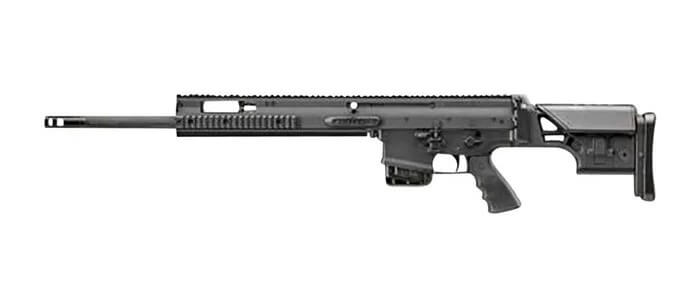
My Review:
The FN SCAR 20S is an exceptional rifle that combines rugged reliability with outstanding accuracy. From the moment I held it, I was impressed by its solid construction and attention to detail.
One standout feature of the SCAR 20S is its chambering in 7.62x51mm NATO, which provides excellent stopping power and long-range capability. The rifle’s gas piston operating system ensures reliable and smooth operation, even in harsh conditions.
Accuracy is paramount in a precision rifle, and the SCAR 20S delivers on this front. It features a cold hammer-forged, chrome-lined barrel that provides exceptional accuracy and consistency. Whether engaging targets at intermediate or extended ranges, the SCAR 20S consistently delivers impressive results.
The rifle’s adjustable gas regulator allows shooters to fine-tune the gas system, accommodating various ammunition types or suppressor use. This versatility adds to the rifle’s adaptability and ensures optimal performance across different shooting scenarios.
Ergonomics play a vital role in a precision rifle, and the SCAR 20S excels in this aspect. Its fully ambidextrous design with adjustable folding stock and an adjustable cheekpiece enables shooters to achieve a comfortable and personalized fit. The rifle’s controls are intuitive and easy to manipulate, further enhancing the overall shooting experience.
Furthermore, the SCAR 20S boasts a robust and reliable magazine system, capable of holding 10 or 20 rounds of ammunition. The magazine release is conveniently located and allows for swift reloads.
Key Features:
- Weight: 11.6 pounds
- Available Calibers: 7.62x51mm or 6.5 Creedmoor
Pros:
- Outstanding accuracy
- Reliable gas piston system
- Fully ambidextrous design
- Adjustable folding stock and cheekpiece
- Reliable magazine system
Cons:
- Only two caliber options
- Higher price point
- Limited aftermarket support
- Larger size and weight
- Non-adjustable trigger
Also Read: MOA vs MRAD Rifle Scopes – Which is Best for Long Range?
13. Ruger Hawkeye Long Range Target Rifle

My Review: The Ruger Hawkeye Long Range Target (LRT) might feel like shooting a brick, but the 11lb rifle provides the precision to make it a rifle you don’t want to overlook.
This rifle was designed to take the beating of a .300 Win Mag cartridge but is also available chambered in 6.5 Creedmoor, 6.5 PRC, .204 Ruger, and .308 Win.
The rifle sits in a composite stock, adding weight and rigidity to the rifle. The stock has adjustable comb height and length of pull to set into the shooter’s body comfortably.
It’s complete with a flush-mounted M-LOK lower rail and QD points to attach bipods or slings as you see fit. The 26” heavy barrel is fitted with the Ruger Precision Rifle Hybrid Muzzle Brake to reduce recoil and make this rifle slightly more comfortable to shoot. This rifle also utilizes 5R rifling in its free-floating barrel.
The Ruger Hawkeye LRT utilizes a 2 stage trigger and is fed by AICS mags. Take this Tack driver home for around $1000 and you’ll be shooting ¾ MOA right out of the box. Whether you’re hunting or target shooting, you’ll be capable of hitting out to 1000 yards with this rifle without any worries.
Key Features:
- Weight: 11 pounds
- Available Calibers: 6.5 Creedmoor, 6.5 PRC, .204 Ruger, .308 Win., and .300 Win Mag.
Pros:
- Accurate and precise
- Adjustable stock
- Ruger Marksman Adjustable Trigger
- Solid construction
- Ample Picatinny rail space
Cons:
- A little heavy
- Limited stock configurations
- Non-adjustable comb height
- Fixed barrel length
Popular Article: 17 Best Thermal Scopes (Ranked by a Marine)
Here is a good video review of the Ruger Hawkeye Long Range Target Rifle that I found on YouTube if you want to learn more about it.
12. Savage 10/110 Precision
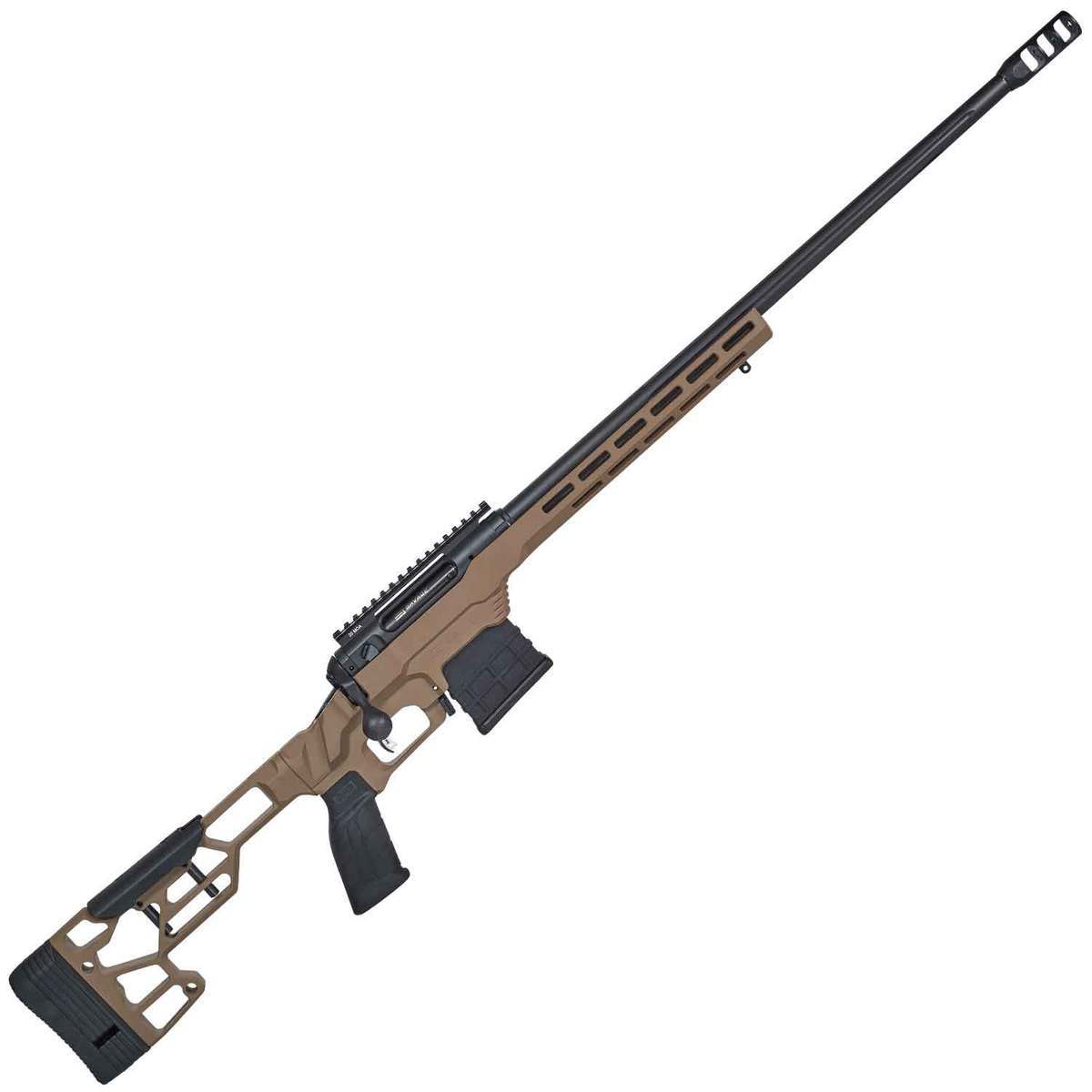
My Review: The Savage 10/110 Precision is an outstanding rifle that combines precision craftsmanship with exceptional accuracy. From the moment I picked it up, I was impressed by its solid construction and attention to detail.
One standout feature of the 10/110 Precision is its renowned AccuTrigger. This adjustable trigger allows for a crisp and clean break, enhancing shooter control and contributing to precise shot placement. It’s one of the best factory triggers available and ensures consistency and accuracy shot after shot.
Accuracy is paramount in a precision rifle, and the 10/110 Precision delivers on this front. It features a heavy-contour barrel that is button-rifled to ensure excellent consistency and accuracy. Whether engaging targets at long range or competing in precision shooting competitions, this rifle consistently delivers exceptional results.
The 10/110 Precision comes with an adjustable stock that provides a comfortable and customizable fit. The length of pull and comb height can be adjusted, allowing for proper alignment and optimal shooting posture. This adjustability enhances ergonomics and accommodates individual shooter preferences.
Additionally, the rifle’s magazine system deserves praise. It utilizes detachable box magazines that are reliable and easy to use. The generous capacity of the magazines allows for more rounds to be carried without the need for frequent reloads, which is especially beneficial in competitive shooting scenarios.
Key Features:
- Weight: 8.9 to 11.25 pounds
- Available Calibers: .300 PRC, .300 Win Mag, .308 Win, .338 Lapua, and 6.5 Creedmoor
Pros:
- Exceptional accuracy
- Adjustable AccuTrigger
- Adjustable stock
- Reliable magazine system
- Solid construction
- Some configurations are very light
Cons:
- Limited aftermarket support
- Non-ambidextrous design
- Limited adjustment range on the trigger
- Some configurations are quite heavy
11. Remington 700 CDL
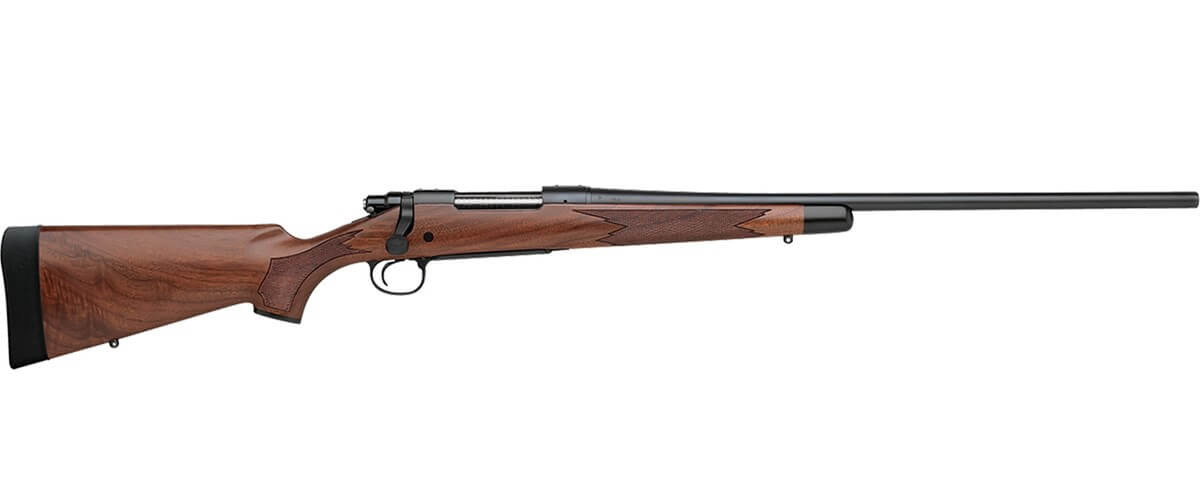
My Review: The Remington 700 is a tried and true, great selection for any type of shooting. Target shooters, hunters, snipers, and collectors, there is a Remington 700 out there for you, so we had to include at least a couple different models, the first of which is the Remington 700 CDL.
The Remington 700 CDL (which stands for “Classic Deluxe” is a classic and time-tested bolt-action rifle that embodies the essence of traditional hunting rifles. It exudes a sense of craftsmanship and delivers reliable performance in the field.
One of the standout features of the Remington 700 CDL is its exceptional build quality. The rifle showcases Remington’s attention to detail and commitment to precision manufacturing. The walnut stock is beautifully crafted and provides a timeless look, while the blued barrel and receiver add to its overall aesthetic appeal. The rifle feels solid and well-balanced, instilling confidence in the shooter.
In terms of accuracy, the Remington 700 CDL is renowned for its consistent performance. It features a free-floating barrel that contributes to excellent harmonics and helps achieve tight groupings. The rifle’s crisp and clean X-Mark Pro adjustable trigger can be fine-tuned to suit individual preferences, further enhancing shot placement and control.
The bolt action on the Remington 700 CDL operates smoothly and reliably. The action is robust and cycles seamlessly, allowing for efficient follow-up shots. Additionally, the three-position safety mechanism provides an added layer of security, ensuring safe handling in various situations.
The Remington 700 CDL is available in a variety of popular hunting calibers, providing versatility to hunters pursuing a range of game species. The availability of both short and long action versions further expands the rifle’s compatibility with different cartridges.
However, it’s worth noting that the Remington 700 CDL does have a few considerations to keep in mind. Some shooters may find the factory trigger pull to be slightly heavier than desired, although it can be adjusted or replaced with an aftermarket trigger if desired. Additionally, the rifle’s walnut stock, while aesthetically pleasing, may require more maintenance and care compared to synthetic stocks, particularly in humid or wet conditions.
Key Features:
- Weight: Around 7.5 pounds
- Available Calibers: .243 Win, 6.5 Creedmoor, .308 Win., .270 Win, .30-06 Sprg, 7mm Remington Mag, and .300 Win Mag
Pros:
- Exceptional accuracy
- Quality construction
- Reliable action
- Adjustable trigger
- Versatility
Cons:
- Limited stock configuration
- Trigger can be a bit heavy and spongey
- CDL has less aftermarket support than some other Remington 700 variants
Also Read: .308 vs. 5.56 – Make the Best Choice for Yourself!
10. Remington 700 ADL

My Review: The Remington 700 ADL is an entry-level variant of the iconic Remington 700 rifle. It is designed to offer reliable performance at an affordable price point, making it a popular choice for shooters who prioritize functionality and value.
One notable feature of the Remington 700 ADL is its solid and durable construction. The rifle features a synthetic stock, which is known for its resistance to harsh weather conditions and durability in various shooting environments. While the synthetic stock may lack the aesthetic appeal of a walnut stock, it offers practicality and functionality, particularly for those who require a rugged and low-maintenance firearm.
The ADL model typically comes with a fixed internal magazine, eliminating the need for detachable magazines. The magazine capacity can vary depending on the caliber, typically ranging from 3 to 5 rounds. While a fixed magazine may not provide the same level of convenience as a detachable one, it contributes to the rifle’s overall simplicity and reliability.
In terms of accuracy, the Remington 700 ADL delivers solid performance. The Remington 700 action, known for its robustness and reliability, forms the heart of the rifle. The bolt-action system operates smoothly and ensures consistent cycling and positive extraction. The ADL model typically features a standard barrel profile, which offers a good balance between weight and accuracy.
The trigger on the Remington 700 ADL is generally decent, but it may not match the precision and crispness of higher-end models. However, it is typically adjustable to some extent, allowing shooters to fine-tune the trigger pull weight to their preference.
While the Remington 700 ADL may lack some of the premium features and aesthetics found in higher-end models, it still maintains the core qualities that have made the Remington 700 platform popular among shooters for decades. It offers reliable accuracy, a robust action, and a durable synthetic stock at an accessible price point.
Key Features:
- Weight: About 7.5 pounds
- Available Calibers: 22-.250 Remington, .223 Remington, .243 Win, 6.5 Creedmoor, .308 Win, .270 Win, .30-06 Sprg, .300 Win Mag, and 7mm Remington Mag
Pros:
- Affordable price point
- Reliable
- Accurate
- Durable synthetic stock
- Versatile range of calibers
Cons:
- Basic features
- Non-adjustable trigger
- Limited magazine capacity
- Limited stock options
9. Savage Impulse Elite Precision
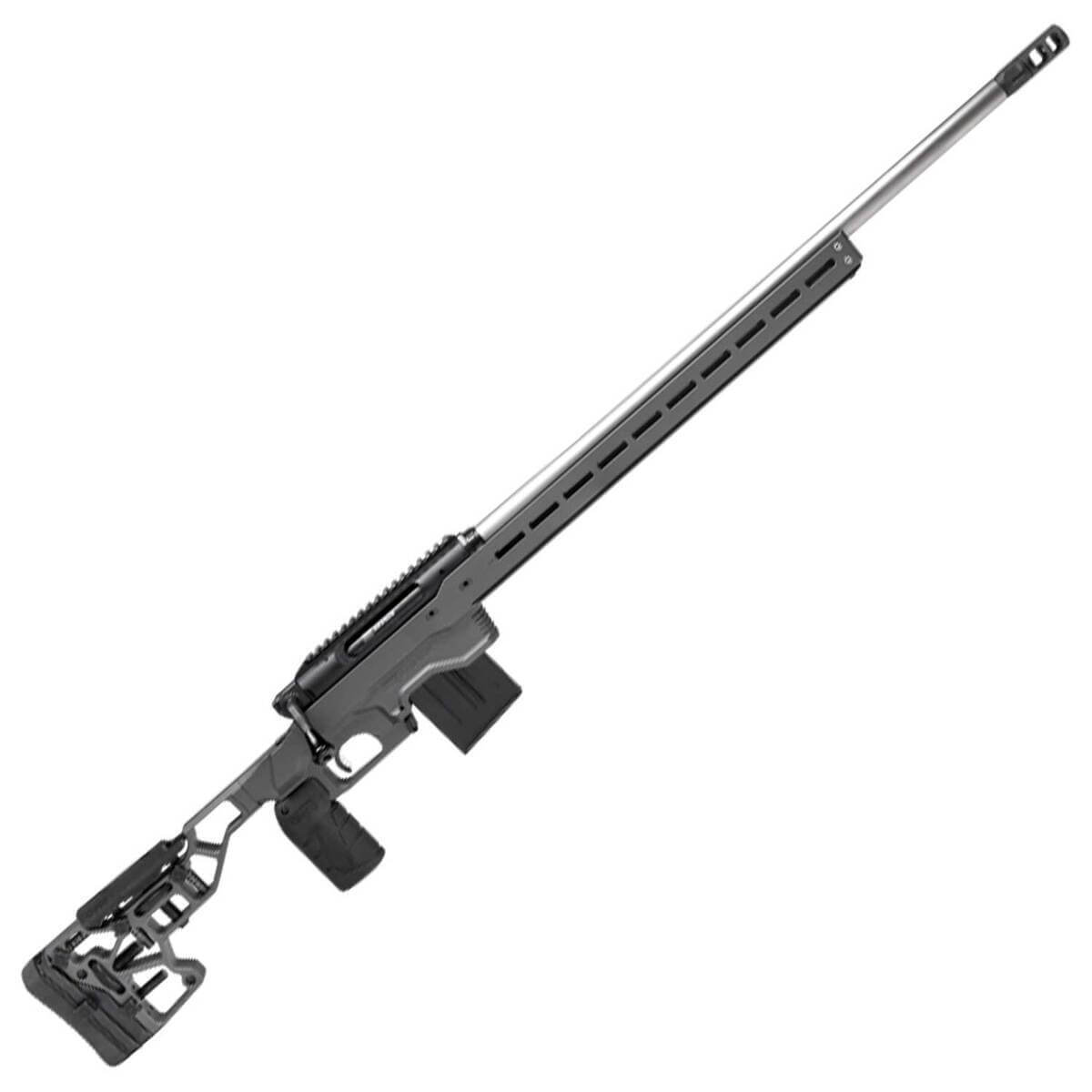
My Review: The Savage Impulse Elite Precision is an impressive rifle that combines innovative features with exceptional precision. From the moment I picked it up, I was struck by its solid construction and ergonomic design.
One standout feature of the Impulse Elite Precision is its unique straight-pull action. Unlike traditional bolt-action rifles, this straight-pull system allows for lightning-fast follow-up shots and smoother operation. The action is incredibly smooth and easy to manipulate, contributing to a seamless shooting experience.
Accuracy is paramount in a long-range rifle, and the Impulse Elite Precision delivers on this front. It features a free-floating, heavy-contour barrel that is button-rifled to ensure excellent consistency and accuracy. The rifle’s adjustable AccuTrigger further enhances precision by enabling shooters to fine-tune the trigger pull to their liking.
The Impulse Elite Precision comes with an adjustable stock that provides a comfortable and customizable fit. The length of pull and comb height can be adjusted, allowing for proper alignment and optimal shooting posture. Additionally, the rifle is compatible with popular aftermarket AR-style grips, making it adaptable to individual preferences.
The rifle’s magazine system deserves praise as well. The detachable box magazine has a generous capacity and feeds reliably, making it convenient for both competitive shooting and hunting scenarios.
Key Features:
- Weight: 13.7 to 15.1 pounds
- Available Calibers: .300 PRC, .300 Win Mag, .308 Win, .338 Lapua, 6.5 Creedmoor, 6.5 PRC, and 6mm Creedmoor
Pros:
- Innovative straight-pull action
- Exceptional accuracy
- Adjustable stock
- Reliable magazines
- Compatible with aftermarket AR-style grips
Cons:
- Straight pull-action comes with a learning curve
- Still relatively new to the market, so compatible upgrades and parts may be limited
- Heavy and bulky compared to a lot of long-range rifles
8. Christensen Arms Modern Precision Rifle
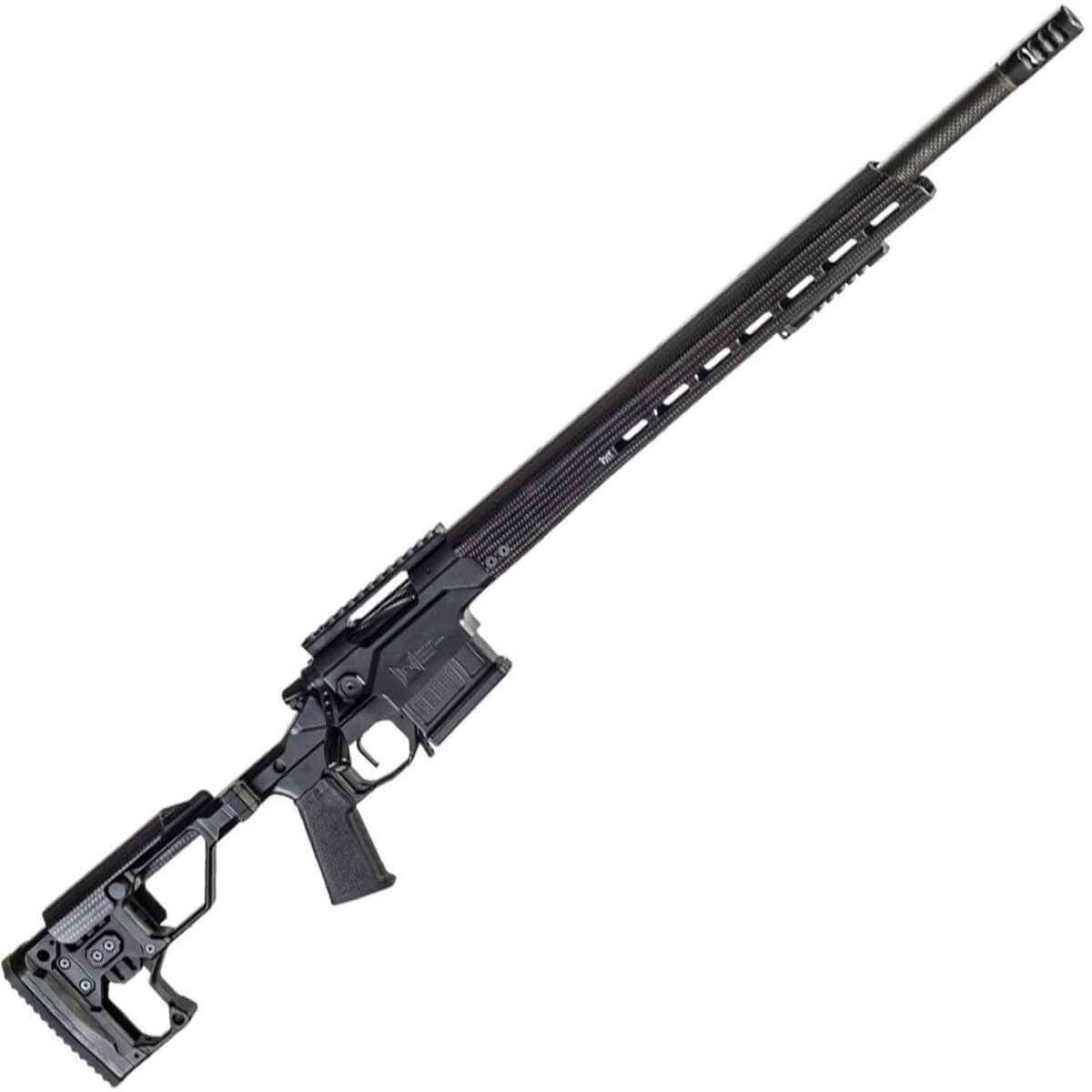
My Review: The Christensen Arms Modern Precision Rifle is a great long-range rifle. I dropped this rifle a couple of slots from the top only because of the price. But don’t be fooled, this rifle will still easily keep up with the top 5 rifles of this list.
The Christensen Arms aluminum V bedded chassis has an adjustable length of pull, cheek riser, and foldable stock. Attached to the Remington-700 footprint receiver is a button-rifled, free-floating barrel with a threaded muzzle. One unique thing about this rifle is that it has a carbon fiber wrapped, 16-27” barrel.
The twin lug, spiral fluted bolt has an M16 style extractor, with an oversized and fluted bolt knob. This rifle utilizes versatile AICS-style magazines. The MPR can be purchased chambered in several different cartridges, including .223 REM, 6MM Creedmoor, 6.5PRC, 6.5 Creedmoor, .308WIN, 300WM, .300NM, .300PRC, and .338LM. Odds are, this rifle is offered in your cartridge of choice! I have seen this rifle shoot factory ammunition often around .75 – 1 MOA.
However, with hand loads, it should tighten the group down to at least .50 MOA. In fact, the rifle comes with a sub-MOA guarantee!
Key Features:
- Weight: 6.9 to 8.1 pounds
- Available Calibers: .223 REM, 6MM ARC, 6MM Creedmoor, 6.5 PRC, 6.5 Creedmoor, 6.8 Western, 7MM PRC, .300PRC, .308 Win, .300 Win, and .338 Lapua Mag
Pros:
- Lightweight construction
- Exceptional accuracy
- Innovative design
- Highly customizable
- Quality craftsmanship
Cons:
- Higher price point
- Heavy recoil
- Ergonomics, but that’s largely personal preference
7. Browning X-Bolt Target Lite Max
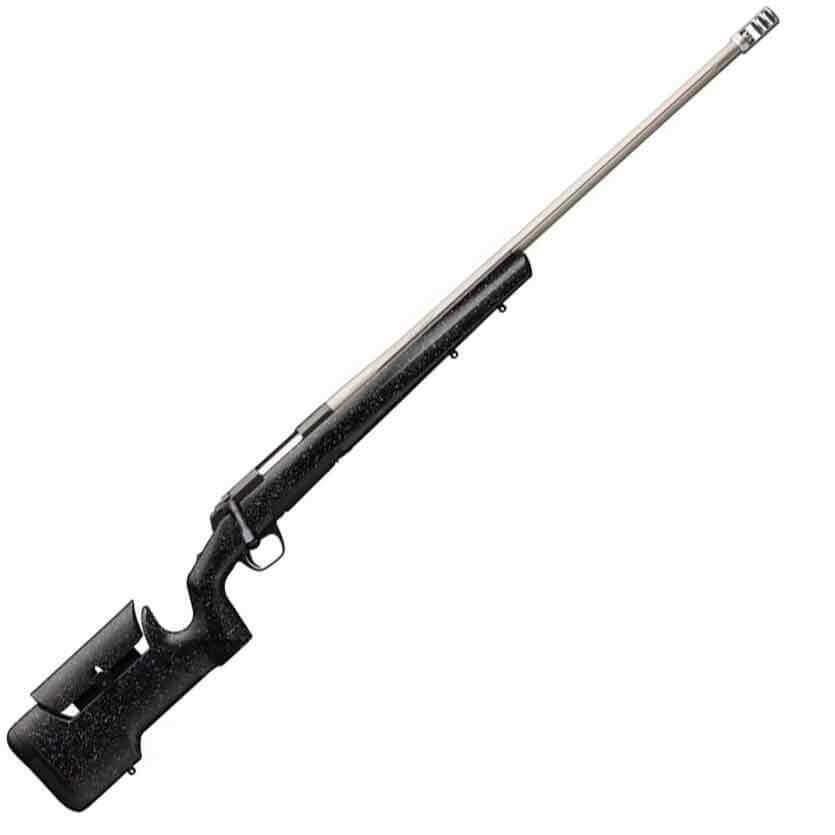
My Review: The Browning X-Bolt Target Lite Max incorporates a range of features aimed at enhancing accuracy, reducing weight, and providing shooter comfort.
The rifle is built on Browning’s renowned X-Bolt action, known for its smooth and reliable operation. It features a heavy-profile, fluted stainless steel barrel that increases stiffness while reducing weight. The barrel is threaded to accommodate a muzzle brake or suppressor.
The composite stock is lightweight and durable, with adjustable length of pull, cheek rest height, and cant. It offers textured grip panels and a soft recoil pad for enhanced control and reduced felt recoil.
The X-Bolt Target Lite Max is equipped with Browning’s Feather Trigger, providing a crisp and adjustable pull. The free-floating barrel and bedded action maximize accuracy potential, while the target crown protects the muzzle and aids in consistent bullet release.
The rifle utilizes a detachable rotary magazine, typically with a capacity of 4 rounds. It has a Picatinny scope rail for easy optic mounting and a tang-mounted safety for quick and instinctive operation. The bolt has a 60-degree throw for smooth cycling.
Key Features:
- Weight: 9 pounds, 2 ounces
- Available Calibers: 6mm Creedmoor, 6mm GT, 6.5 Creedmoor, and .308 Win.
Pros:
- Accuracy
- Adjustable stock
- Lightweight design
- Threaded barrel
- High-quality construction and materials
Cons:
- Limited Caliber options
- Mid-to-high price point
6. Weatherby Mark V Hunter Bronze
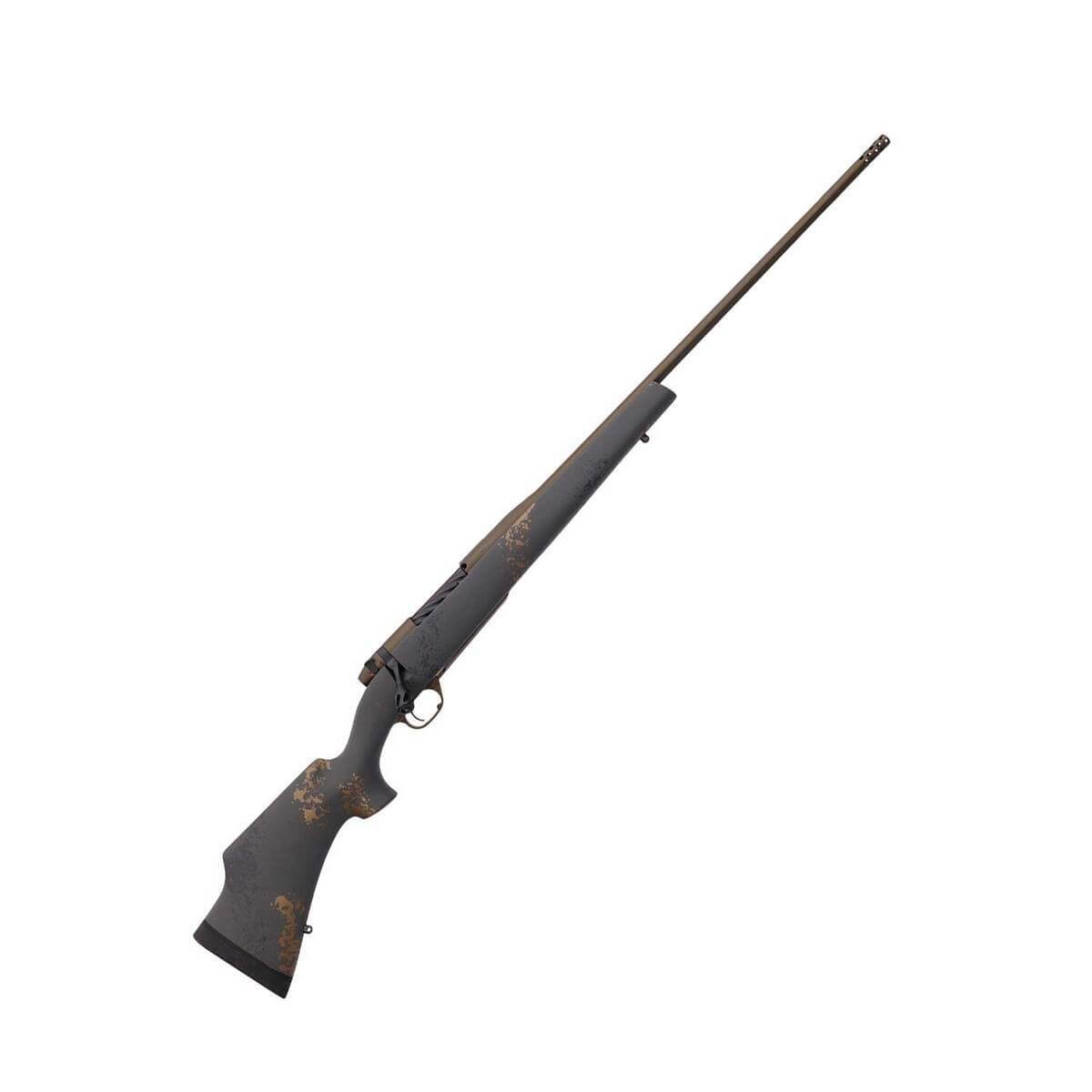
My Review: The Weatherby Mark V Hunter Bronze is a rifle designed for hunters who prioritize both performance and aesthetics. It belongs to the renowned Mark V line from Weatherby, known for their exceptional craftsmanship and accuracy.
The rifle features a Monte Carlo-style stock made of hand-laminated, high-grade walnut. This not only provides a classic and timeless appearance but also ensures durability and stability in various weather conditions. The stock is designed to offer a comfortable and ergonomic shooting experience, with a raised comb and textured grip.
With a matte-bronze Cerakote finish on the metal surfaces, the Mark V Hunter Bronze boasts both a rugged and weather-resistant coating. This finish enhances the rifle’s durability while adding to its aesthetic appeal.
Built on Weatherby’s proprietary Mark V action, the rifle delivers strength and reliability. The action ensures smooth and consistent cycling, contributing to its overall accuracy.
Typically chambered in Weatherby’s powerful magnum calibers, the Mark V Hunter Bronze is well-suited for hunting various game species, especially at extended distances due to their flat trajectory and long-range capabilities.
The rifle incorporates a cold hammer-forged barrel that is free-floated to maximize accuracy. The fluted design helps reduce weight and improve heat dissipation during prolonged shooting sessions.
Additional features include a match-quality, two-stage trigger with a crisp and predictable break, as well as a three-position safety located on the bolt shroud for convenient engagement and disengagement without compromising the shooting position. The hinged floorplate magazine offers reliable and convenient reloading.
Key Features:
- Weight: 6.1 to 7.3 pounds
- Available Calibers: .240 Weatherby Magnum, .243 Win, .25-06 Rem., .257 Weatherby Magnum, .270 Weatherby Magnum, .270 Win., .280 AI, .30-06 Spring, .300 Weatherby Magnum, .300 Win., .308 Win, 6.5 Creedmoor, 6.5 WBY RPM, 6.5-300 Weatherby Magnum, 7mm Rem., 7mm Weatherby Magnum, and 7mm-08 Rem.
Pros:
- Classic aesthetics
- Weather resistance
- Powerful and accurate
- Comfortable ergonomics
- Reliable Mark V action
Cons:
- Significant recoil, especially with heavier calibers
- While the Weatherby Mark V is available in a bunch of different calibers, many of them are Weatherby’s own magnum calibers, which aren’t ideal for shooters who want smaller or less powerful cartridges
- Limited aftermarket customization options
- Higher price point
5. Howa 1500 Hogue Rifle
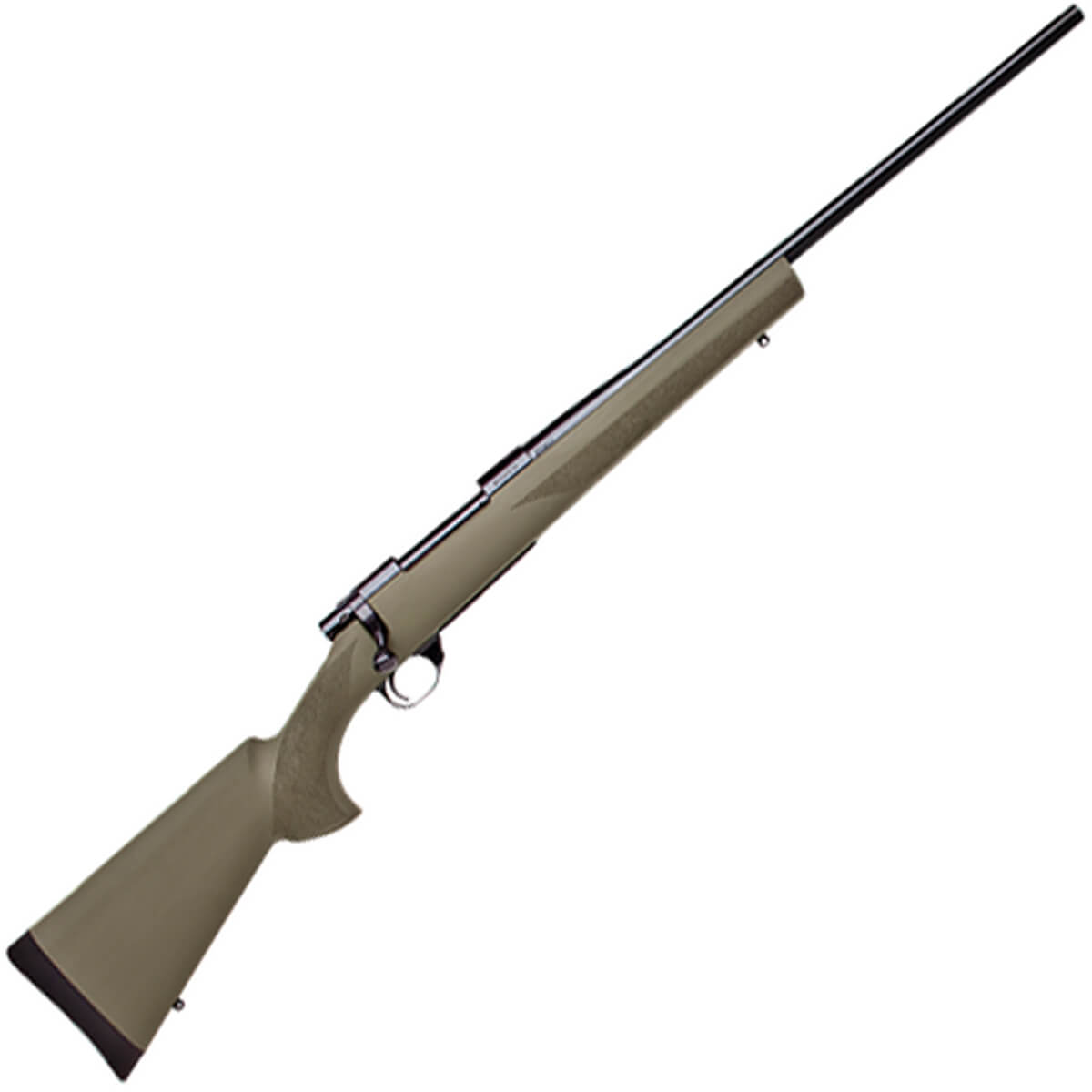
My Review: The Howa 1500 Hogue Rifle is a popular bolt-action rifle known for its reliable performance, affordability, and comfortable ergonomics. It combines the Howa 1500 action with a Hogue Overmolded stock, resulting in a capable and user-friendly firearm.
The rifle features a solidly built barreled action based on the Howa 1500 platform. Its smooth operation and consistent performance have earned it a solid reputation. The blued finish on the action provides protection against corrosion, ensuring durability.
The Hogue Overmolded stock is a standout feature of this rifle. Made from synthetic material with a rubberized coating, it offers a comfortable and secure grip. The stock also includes a soft recoil pad, reducing felt recoil and enhancing shooting comfort.
Accuracy is a strong suit of the Howa 1500 Hogue Rifle. The free-floating barrel and well-bedded action contribute to its consistent performance. The hammer-forged barrel ensures excellent quality and longevity, promoting accuracy over time.
Popular Article: 17 Best Tactical Pants (Ranked by a Marine)
Chambered in various calibers, the rifle caters to different shooting needs such as hunting, target shooting, or casual plinking.
Additional features include a three-position safety at the rear of the action for convenient operation and a smooth-cycling two-lug bolt. The trigger, while not adjustable out of the box, is generally crisp and breaks cleanly.
The rifle typically comes with a detachable box magazine for quick and easy reloading. Magazine capacity varies depending on the model and caliber.
Key Features
- Weight: 8 pounds
- Available Calibers: .22-250 Rem, .243 Win, 6.5 Creedmoor, .308 Win, .270 Win, .30-06, 7mm Rem Mag, 300 PRC, 6.5 PRC
Pros:
- Reliable performance and consistent accuracy
- Comfortable and secure grip with the Hogue Overmolded stock
- Affordable pricing, especially for the features and performance
- Versatile caliber options
- Solid construction
Cons:
- Limited customizations options
- Trigger lacks adjustability out of the box
4. Bergara Premier Ridgeback

My Review: The Bergara Premier Ridgeback is a precision bolt-action rifle that offers exceptional accuracy and craftsmanship. It is designed to meet the demands of serious long-range shooters and hunters who value high-quality components and meticulous attention to detail.
Constructed with a stainless steel barrel, the Ridgeback provides excellent resistance to corrosion and durability. The barrel is precision machined and features a proprietary Bergara #5 contour, known for its stiffness and stability. The barrel’s muzzle is threaded to accommodate muzzle devices or suppressors, enhancing its versatility.
Related Article: 16 Best Spotting Scopes (Ranked by a Marine)
The Ridgeback is built on a solid and reliable Remington 700-style action, which has a proven track record in the industry. The action is designed for smooth cycling and precise lockup, ensuring consistent and repeatable accuracy. It is often equipped with a two-lug bolt with a sliding plate extractor and a plunger-style ejector for reliable extraction and ejection of spent casings.
One of the notable features of the Ridgeback is its adjustable precision stock. It is constructed from a combination of carbon fiber and fiberglass, resulting in a lightweight yet robust platform. The stock features an adjustable cheekpiece and length of pull, allowing shooters to achieve a comfortable and customized fit. It also incorporates M-Lok slots for attaching accessories or bipods.
The Ridgeback typically comes with a crisp and adjustable trigger that can be fine-tuned to suit individual preferences. It is designed to break cleanly and predictably, contributing to the overall accuracy of the rifle.
When it comes to accuracy, the Bergara Premier Ridgeback excels. It is known for delivering sub-MOA (Minute of Angle) groups, meaning it can consistently produce groups of shots within 1 inch at 100 yards or even better. This level of precision makes it well-suited for long-range shooting and hunting applications.
Key Features:
- Weight: 10 to 10.7 pounds
- Available Calibers: 6mm Creedmoor, 6.5 Creedmoor, 6.5 PRC, .308 Win, .28 Nosler, .300 Win Mag, and .300 PRC
Pros:
- Exceptional accuracy with sub-MOA capabilities
- High-quality stainless steel barrel for durability and corrosion resistance
- Solid and reliable Remington 700-style action
- Adjustable precision stock for a customized fit
- Crisp and adjustable trigger for precise shot control
Cons:
- High-end price point
- The adjustable stock, while beneficial for customization, may require some time and effort to find the optimal settings for each shooter
3. Tikka T3x TACT A1 Rifle
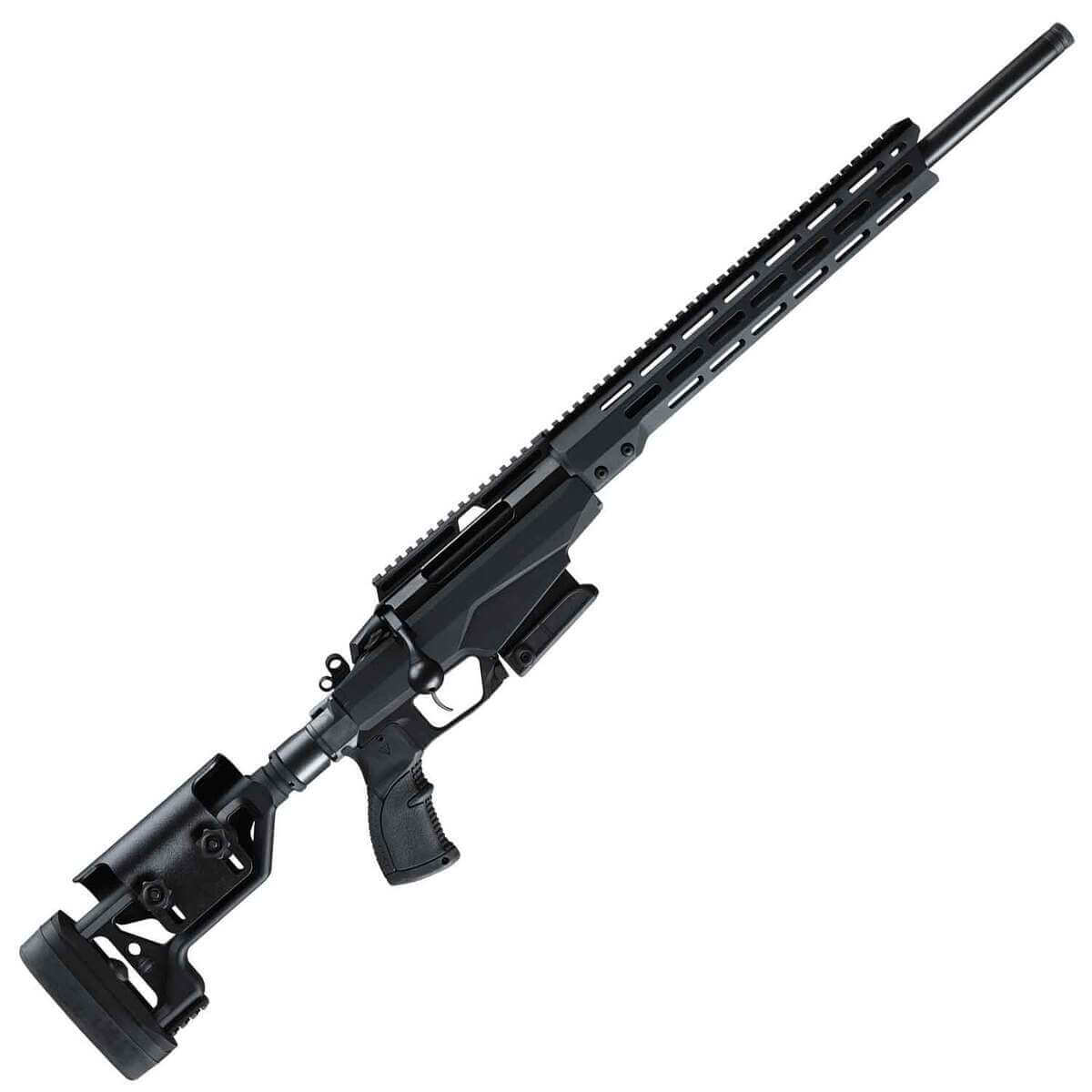
My Review: Tikka was founded in the early 1920s in Finland. 100 years of quality gunsmithing has earned Tikka a top spot in the precision rifle market. Simo Hayha, the legendary Finish sniper of the 1939 Winter War, credited with 259 sniper kills, would surely be proud to carry this rifle into battle.
Unlike most popular bolt action rifles, the T3x is not a Remington 700 clone. There are no clone actions that share the same footprint. Tikka designed the action and then designed a chassis system specifically for the action. The center of the chassis is a solid aluminum block that houses the action, magazine, and trigger and serves as the anchor to the side folding stock.
It is equipped with an adjustable two-stage trigger, an M-Lok fore-end with QD mounts, a side folding stock with adjustable length of pull and cheekpiece, and a free-floating threaded barrel. The efficiently designed bolt lugs provide a shorter bolt throw than most two-lug bolts, which leads to light and fast cycling of the bolt.
The T3x does not accept standard AICS magazines and instead uses Tikka’s own center feed, double stack magazines which sell for around $40-$50 for a 5-round magazine. This 9.5lb rifle comes chambered in 6.5 Creedmoor, .308 win, and .260 Rem. Tikka guarantees all T3x rifles at 1 MOA accuracy, but you can expect much tighter groups with quality ammunition.
Key Features
- Weight: 8.8 to 10.6 pounds
- Available Calibers: .223 Rem, 6.5 Creedmoor, .308 Win, and .260 Rem.
Pros:
- Exceptional accuracy
- Excellent build quality
- Comfortable ergonomics
- Versatility
- Smooth bolt action
- Crisp and adjustable single-stage trigger
Cons:
- Limited customization
- Limited magazine capacity
- Higher price point
- Some models can be weighty
2. Bergara B14 HMR

My Review: The Bergara B14 HMR (Hunting and Match Rifle) comes from a Spanish manufacturer in Bergara, Spain.
This rifle really is a great combination of a lightweight hunting rifle and a rigid match rifle. You could take it straight off the range after a day of steel plate shooting, to a hunting trip hiking through the woods.
While taking on more of a traditional hunting rifle look, the buttstock still has an adjustable length of pull and adjustable cheekpiece! Fitted inside the polymer stock is what Bergara calls their “mini chassis”. Running from the grip to the forend, this aluminum skeleton really gives this work of art the rigidity it needs to provide extreme precision.
Popular Article: 30 Best Fixed Blade Knives (Ranked by a Marine)
The bolt runs quick and smooth and feeds cleanly with its extremely versatile AICS magazines. It’s equipped with the Bergara curved trigger set at about 3 lbs. This rifle is available in .22-250, 6.5 Creedmoor, 6.5 PRC, .308 Win, .300 Win Mag, 300 PRC, and .450 Bushmaster. While it comes with a 20″-26″ threaded barrel, it does not come with a muzzle device, instead, a thread protector is included. All B14 rifles are guaranteed by Bergara to produce 1 MOA groups at 100 yards with quality off-the-shelf ammo.
Key Features:
- Weight: Starting at 9.5 pounds
- Available Calibers: .308 Win, 6.5 Creedmoor, 22-250, 450 Bushmaster, 6.5 PRC, 300 Win Mag, and 300 PRC
Pros:
- Accuracy
- Quality construction
- Adjustable stock
- Smooth bolt action
- Versatility
- Crisp, adjustable trigger
Cons:
- Relatively heavy
- Limited customization
- Limited magazine capacity
Here is a good video review of the Bergara B14 HMR that I found on YouTube if you want to learn more about it.
1. Ruger Precision Rifle

My Review: The Ruger Precision Rifle is a serious rifle for the money. It has been a hot seller since the day it was released and it just seems like people cannot get enough of the RPR. I even believe that the RPR is a major reason for the increase in interest in long-range precision shooting.
The bolt action rifle, based on the looks of the MSR, is equipped with a fully adjustable skeleton-style buttstock, but can be swapped with any AR shoulder stock. The aftermarket parts available to the RPR are endless. It is sporting a threaded, Cold hammer-forged, chrome-moly steel barrel with 5R Rifling, an externally adjustable 2.25lb-5lb Ruger Marksman Adjustable trigger, the RPR Hybrid muzzle brake, and an aluminum free-floating handguard.
Popular Article: 17 Best Long Range Calibers (Ranked by a Marine Sniper)
As mentioned before, all of these parts can be easily swapped at home, and customization possibilities are endless. The RPR is offered in 15 models .308, 6.5 Creedmoor, 6.5 PRC, 6mm Creedmoor, .338 Lapua Mag, 300 Win Mag, and 300 PRC. Average group sizes are around ½ MOA with factory loads. Grab one of these rifles at almost any reputable gun store, equip a decent scope, and you’ll be ready to take on targets stretching out EASILY to 1000 yards.
Key Features:
- Weight: 9.8-15.2 pounds
- Available Calibers: .308 Win, 6.5 Creedmoor, 6.5 PRC, 6mm Creedmoor, .338 Lapua Mag, 300 Win Mag, and 300 PRC.
Pros:
- Accuracy
- Adjustable stock
- Modular design
- Compatible with AR-style accessories
- Smooth bolt action
- Price, especially for the quality
Cons:
- Heavy
- Heavy contour barrel can be prone to heating
- Trigger pull is heavy out of the box
- Magazine compatibility
Here is a good video review of the Ruger Precision Rifle that I found on YouTube if you want to learn more about it.
FAQs
For rifles, typically, long-range refers to the distance anywhere above 500 meters for rifles. In longer ranges, bullets have longer flight times and accuracy is reduced.
A bullet from a rifle can travel to distances between 200 to 600 yards. Small shots can travel between 200-350 yards and larger shots can travel above 600 yards.
To hit 1000 yards, you must know the basics, choose the right tools, ammunition, and modifications as per the environmental factors.
With the required practice, you will be able to hit the targets.
There is no best caliber as such. It depends on the environment, the rifle you are using, and the purpose for which the caliber is used.
Common calibers are 300 WinMag and 6.5 Creemdoor.
Your Thoughts:
As mentioned earlier, there are lots of great long range rifles out there. Let me know your favorites or if there are any that you think should be included on this list.

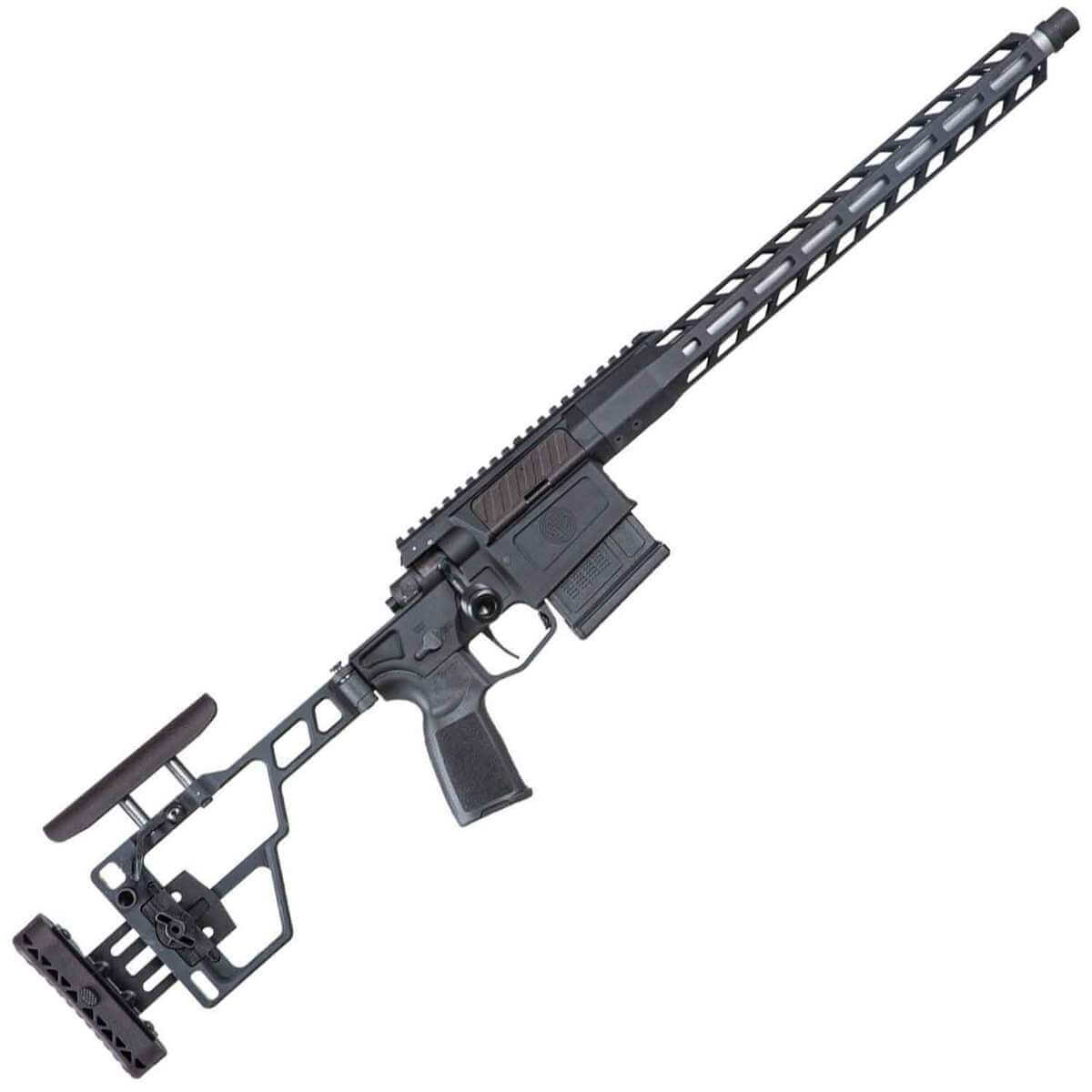

Hi. Interesting list. What are your thoughts on Accuracy International? Particularly the AW in 308 and the AX in 6.5 Creedmoor. I use both at 1000 yards at Bisley in the UK and get a more accurate grouping with the 308. – Robert
I like the detailed analysis of the best guns in the market today – I’m considering buying a Remington 700 PCR mainly because of price and then Ruger Precision Rifle as 2nd choice. You have the Remington 700 PCR rated at #10 and now might be changing my mind to Ruger. Why do you have the Remington rated at number 10?
RE: Savage Model 110 FCP
About 7 years ago I bought one of these. Out of the box my first 3-shot group was 0.5″ MOA. I regularly shoot the rifle with the same 0.5″ MOA accuracy. I’ve shot it less than 0.5″ MOA a time or two. I was so impressed that within a week of buying the rifle I bought a second one, both for less than $1100 each.
The second rifle shoots 0.5″ MOA regularly. The only reason the rifles miss that accuracy is me, my lack of practice or because I’m just getting old.
I was so surprised I became a real Savage fan. I had a 110 BA before that but it was a 20 lb rifle with scope, ammo, and accessories. It too was a 0.5″ MOA rifle regularly.
Just my thoughts.
Mark
This is great information for a man new to shooting. I am 71 living in Phoenix, AZ. I bought an EXTRA EP9 (a 9mm with shoulder piece) for protection and started to go to the shooting range. Lots of fun and I can hit a 2 inch target at 28 yards 8 out of 10 times. I joined the Phoenix rod and gun club where they have ranges up to 500 yards. I want to get into the precision long range shooting. I thought about starting out with a good .22 rifle with a scope. I sure would like to find some instruction in this area. I have the funds to buy one of the rifles in this article and pair it with one of the scopes in your article about scopes. I would like something good and simple to break down and operate. Any help would be greatly appreciated.
Sincerely,
Hans H. Huyer
206 954 1062
Could I get your opinion on a Thompson/Smith and Wesson LRR in 6.5 Creedmoor.
Thank you for your insight. I am looking for a long rifle for when I get back to the states.
I see you were 22nd MEU. Any chance you were in Northern Iraq in 2016. We may have crossed paths.
I’ve owned three of these beasts in 338 and I agree with you 100 percent. All three shot 1 ragged hole at 100. I hade a small 16’” wide rock that was only 4” high at 1150. I layered it, dialed up the elevation and drilled that sucker dead center. The plume of rock dust blew 40’ in the air with a resounding whack!
I enjoy long range target shooting but after having shoulder replacement surgery my shoulder does not like higher calibers in bolt and lever type actions. Do you give up a lot of accuracy with something such as a AR-10?
I would avoid the Remington. I purchased a M700 P MLR in .338 Lapua and it wouldn’t shoot into 3 inches at 100 yards. I contacted Remington and they said that that was acceptable accuracy. I had several well known and reputable precision rifle builders check it out and they all said it was due to the bore being too rough as scoping it showed very large very rough spots on the lands (I still have the barrel). Through my contacts, I was able to get someone from their corporate HQ to do something. I delivered it to their Ilion NY plant and they had it for over 10 months, replaced the factory bedded stock with a similar one that was NOT bedded and they did nothing more. The target they included with the rifle was of a 3 shot, 2.25 inch group fired at 40 yards. I sent the rifle to another builder to have it re-barreled, trued and bedded. I was able to get it to shoot sub MOA but only after spending another $1500 and not having the rifle for over a year total.
I have a RPR in 308 and I really am impressed with it. I adjusted the trigger to about 2.5 to 2.75 lbs put a viper muzzle break on and an oversized mag release. Then added a dragon scale bolt knob. Not much budget left, but put a Trinity force 10X40 on top, and have only had the chance to get out 100 yards but have about a 3/4 group with multiple loads and weights. Not my hunting rifle but a lot of fun to take to the range and show off.
I don’t understand why no one is making rifles in 300, 7mm WSM both are very good rounds.